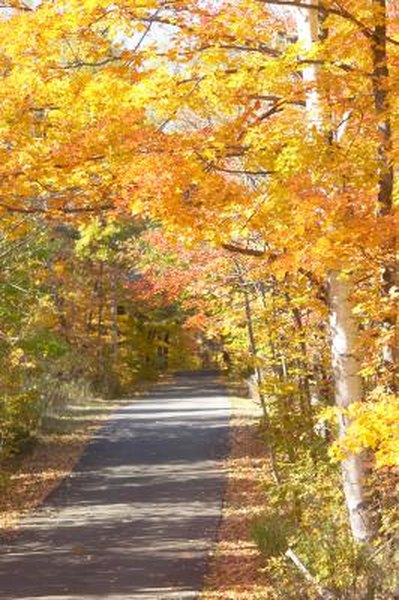
Walking trails allow you to explore, ponder and improve your heart-health in a natural, serene setting. When designing a walking trail, think about what type of plants and trees you want in the area. People enjoy walking on trails with foliage, but trees and shrubs should not block walker visibility. Add benches to strategic points so that walkers have a place to rest. If you have the ability to create a marked trail, add informational pictures that educate walkers about the environment and the history of the area.
Wood Bark
Wood bark is a relatively inexpensive material to use for a walking trail. However, it also provides a less-than-even walking surface. Wood bark typically does not last as long as gravel or asphalt because of erosion and oxidation of the wood. If wood bark is not readily available, you can also use crushed bark, which has many of the same properties.
Gravel
Gravel is an alternative to wood bark for a walking-trail surface. Railroad ballast gravel, 57 gravel, P gravel, river rock and crusher run are all appropriate types of gravel to use. However, railroad gravel is unsafe to walk on and should only be used as a paving surface. If you decide to pave with railroad gravel, lay asphalt over it to ensure a safe walking trail.
Asphalt
Asphalt is an expensive surface to use for walking trails, but it is also the longest lasting. Many walking trails are designed with asphalt because of it’s very low maintenance. It can also be painted with directions or an artistic design. Another bonus of asphalt is that you do not necessarily need to install edging. The recommended depth for asphalt trails is 4 inches or 2 inches. Typically a 4-inch depth is best if you are building over topsoil, but 2 inches is acceptable if you are working on a gravel base. Generally, 1 ton of asphalt that is 4 inches deep can pave a 6-foot-wide walking trail for 7.5 feet; and 2 inches will provide 15 feet.
Edging Materials
Plastic edging, timber and packed dirt banking can all be used to create a surface edge for your walking trail. Packed dirt is the cheapest option for edging, but it erodes easily and has a short lifespan. Plastic edging is useful if you have a very curvy path because it can be easily shaped to fit around tight corners. However, it does not have as long of a lifespan as wood materials. Timber has a longer lifespan than plastic and is very low maintenance, but is usually more expensive than plastic edging.
References
Writer Bio
Based in San Diego, Calif., Madison Garcia is a writer specializing in business topics. Garcia received her Master of Science in accountancy from San Diego State University.



